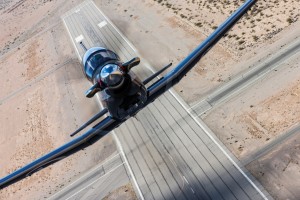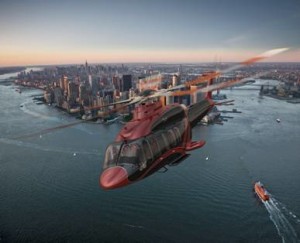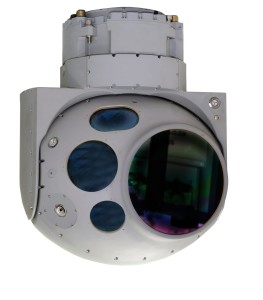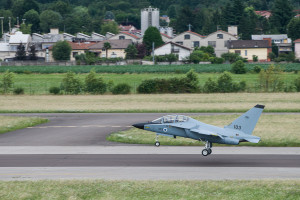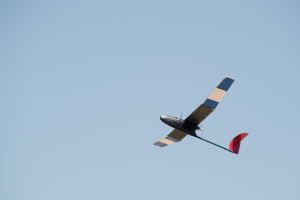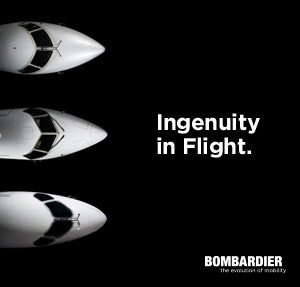Beechcraft T-6 sets industry standard for military training offering
July 15, 2014
Beechcraft Defense Company highlights military offerings at Farnborough International Airshow
FARNBOROUGH, U.K., July 15, 2014 – Beechcraft Defense Company is highlighting its portfolio of military and defense products and services at the Farnborough International Airshow this week, emphasizing recent program milestones and orders. The company is displaying its T-6C trainer and AT-6 light attack aircraft at the Textron Aviation chalet in Farnborough, United Kingdom.
In addition to delivering a variety of aircraft platforms for military operations, Beechcraft also supports fielded military aircraft through its Global Mission Support division, offering logistics support, customized maintenance training, spare parts support and aircraft modification/upgrade programs.
Beechcraft prepared to deliver New Zealand T-6 aircraft on-time
Beechcraft Defense Company today announced that the first two Royal New Zealand Air Force (RNZAF) Beechcraft T-6C aircraft have been completed ahead of schedule and will depart for New Zealand from its headquarters in Wichita, Kan., later this month. The company announced the contract award in January, which includes 11 T-6C trainer aircraft, spare parts, training, logistics and maintenance support.
In preparation for introduction into service activities to begin on schedule later this year, the maintenance training will begin after the first two aircraft arrive in country in August. Formal acceptance of the aircraft will occur in November, with full capability in January 2016.
“Our relationship with the customer and the status of the contract are evidence of Beechcraft’s industry-setting standard for aircraft production, sustainment and training,” said Russ Bartlett, president, Beechcraft Defense Company. “We are slated to deliver the certified aircraft on time and just seven months after contract award, backed by a fully integrated aircraft, logistics and training system.”
The remaining RNZAF aircraft have started on the production line ahead of schedule and all 11 T-6C aircraft will be delivered by the second quarter of 2015, just 17 months after contract signature.
In addition to the aircraft, the contract includes spare parts, logistics, training and maintenance support. The contract includes two CAE operational flight training simulators, computer-based training courseware and a customized RNZAF pilot training syllabi – all of which are integrated to create a comprehensive leading edge learning management system. A 30-year logistics support agreement provides turnkey support for the RNZAF flight training operations. The logistics agreement consists of aircraft material support, full flight line and operational maintenance, as well as support and operation of the synthetic training devices.
T-6 contract with U.S. Government
Beechcraft Defense Company announced that it signed a contract in May with the U.S. Air Force for production of 29 Beechcraft T-6 training aircraft. Valued at $171 million, this represents the 20th production lot of T-6 aircraft ordered by the U.S. Air Force (USAF), U.S. Navy (USN) and U.S. Army as part of the Joint Primary Aircraft Training System (JPATS) procurement program.
“Throughout the past 14 years, we have worked closely with the U.S. Government to provide every T-6 aircraft in the program on time or ahead of schedule and on budget,” Bartlett said. “These aircraft, which are used to train every USAF and USN pilot, are a symbol of our commitment to the U.S. armed forces and the missions they carry out.”
Production of the Lot 20 aircraft will begin in 2015 with deliveries to the USN scheduled for mid-2016. The entire JPATS program represents 751 T-6 aircraft.
“We’ve had great wins for the Beechcraft T-6 training program recently that further solidify the longevity of the program and reinforce the relevance and proven capabilities of the platform around the world,” Bartlett said. “Since deliveries began some 14 years ago, these 850 aircraft have been used to train pilots, navigators and weapon systems operators from more than 25 countries worldwide.”
T-6 10,000 flight hour milestone
Further demonstrating the proven capability of the T-6 platform, three of the 23 T-6A aircraft operated at the NATO Flying Training in Canada (NFTC) Program recently reached the 10,000 flight hour milestone.
“We are proud to support the NFTC Program and congratulate them on reaching this milestone,” Bartlett said. “While its T-6A fleet has already been a proven workhorse for many years, we know the aircraft will last for generations to come training new military pilots around the globe.”
The Beechcraft T-6 military training fleet has surpassed 850 aircraft worldwide with more than 2.5 million flight hours. The T-6 military trainer offers military operators worldwide the most proven and cost-effective primary aviation training system available today. Aircraft deliveries began in 2000 after the T-6 was selected to fill the JPATS role for the U.S. Air Force and the U.S. Navy. Since then, additional military customers worldwide have selected the T-6, including the NFTC Program, the Hellenic Air Force of Greece, the Israeli Air Force, the Iraqi Air Force, the Royal Moroccan Air Force, the Royal New Zealand Air Force, the Mexican Air Force and the Mexican Navy.
Mexican Navy takes delivery of first of four Beechcraft King Air 350ER aircraft
July 15, 2014
FARNBOROUGH, U.K., July 15, 2014 – Beechcraft Corporation, a subsidiary of Textron Aviation Inc., a Textron Inc. (NYSE:TXT) company, announced today at the Farnborough International Airshow that it has delivered the first of four Beechcraft King Air 350ER aircraft ordered by the Mexican Navy Secretaría de Marina (SEMAR). In addition to the aircraft, Beechcraft will support SEMAR with on-the-ground service, support and training through its Global Mission Support organization.
Rear Admiral Jose Marie Macedo, Director General of Naval Aviation Operations, visited company headquarters in Wichita, Kan., to accept delivery of the aircraft, which will be stationed at the naval base in Veracruz. The remaining three aircraft will be delivered by the second quarter of 2015.
“SEMAR recognizes the Beechcraft King Air as a cost-effective and reliable partner for special missions work within the country,” said Dan Keady, vice president, Special Missions. “The Mexican Navy operated a King Air C90 in the past and it’s great to see the King Air family return to its fleet. The delivery of the King Air 350ER further expands the Beechcraft relationship with SEMAR, which earlier this year placed an initial order for two T-6C+ military trainers.”
This week at Farnborough, the Textron Aviation display includes a specially modified Beechcraft King Air 350ER, which is operated out of Northern Europe and fitted with a unique and flexible mission package that supports search and rescue, fishery inspection, pollution monitoring and seaway/shipping lane surveillance missions. The King Air 350ER was selected for these missions due to its high dash speeds, long endurance, high reliability and low operating cost.
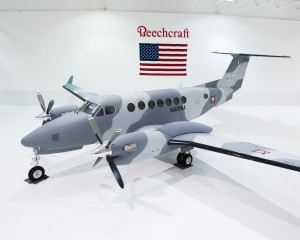
TRU Simulation + Training and Bell Helicopter Announce Collaboration to Build Bell 525 Full Flight Simulator
July 15, 2014
FARNBOROUGH INTERNATIONAL AIR SHOW, ENGLAND (July 15, 2014) – Bell Helicopter and TRU Simulation + Training (TRU), both Textron Inc. companies, (NYSE: TXT), announced an agreement for TRU to complete the design, development, manufacturing, installation, testing and certification of the Bell 525 Level D Full Flight Simulator (FFS).
The FFS will be certified to FAA Level D, as well as EASA/JAA Level D. TRU will employ its ODYSSEY™ H FFS simulator product, which utilizes TRU’s state-of-the-art Ultra High Definition Visual System with 240 degree horizontal by 80 degree vertical field of view Visual Display, in the design and development of the Bell 525 FFS. The ODYSSEY H is capable of meeting EASA and FAA Level D helicopter certifications. The simulator is designed especially for the unique training requirements and needs of the helicopter pilot.
“Our company includes service as a trusted high fidelity rotorcraft simulation and training partner to the military for more than two decades,” explained TRU Simulation + Training President and CEO Jim Takats. “It’s exciting for our team to apply that expertise to the civil market by meeting the training needs of operators of this game-changing Bell Helicopter platform.”
TRU will use the Bell 525 design and components to develop and deliver a flight compartment which is an exact duplicate of the Bell 525 cockpit, forward of the anti-torque pedals to aft of the pilots’ seats. All controls, panels, instruments, avionics, equipment and furnishings will be identical in appearance, feel, location and operation to those of the actual aircraft. It will respond exactly like the aircraft in all flight conditions, as well as accurately simulate instrument readings and malfunctions and enable them to be addressed through normal and emergency procedures.
“We are pleased to be collaborating with TRU in the development and production of the Bell 525 FFS,” said Eric Cardinali, executive vice president, Bell Helicopter Customer Support and Services. “Their expertise in aviation simulation and training solutions is a perfect complement to Bell Helicopter’s own industry-leading training capabilities.”
The simulator will be built at TRU’s facility in Tampa, Fla., and is expected to be fully operational in Q1 2016, to coincide with the certification timeline for the actual aircraft.
“We have kept the customer in mind throughout the FFS development process,” continued Cardinali. “The timing of the simulator installation and certification is such that operators can enroll in training and be certified to fly the aircraft by the time they take delivery.”
TRU Simulation + Training was formed in April out of three legacy companies – Mechtronix Inc. and OPINICUS Corporation that were acquired by Textron late last year, and a portion of the former AAI Logistics & Technical Services.
Press Conference Invitation @ Farnborough
July 11, 2014
We are pleased to invite you to the
Interjet Technical Media Briefing on the SSJ100 Operations
on the occasion of the International Farnborough Airshow
July 14, 2014 at 10.00 a.m.
at the United Aircraft Corporation (UAC) Chalet, Row B 7-10, VIP Room
The Chief Executive Officer of Mexican airline Interjet, Mr. Jose Louis Garza will provide Media with an update on the SSJ100 operations and performance starting from the EIS with the Mexican airline in September 2013.
The briefing will deal with an overview on the SSJ100 utilization and its operative results, dispatch reliability, technical support, current routes, expected network and future perspectives in the market of the Americas.
The President of United Aircraft Corporation Mikhail Pogosyan, the Chief Executive Officer of Alenia Aermacchi Giuseppe Giordo, the Chief Executive Officer of SuperJet International Nazario Cauceglia and the Chairman and CEO of PowerJet Claude Poulain will be attending the Media Briefing.
We look forward to seeing you!
Successful test-flight of IAI’s advanced electro-optical payload M-19HD
July 9, 2014
July 09, 2014– Israel Aerospace Industries’ (IAI) innovative M-19HD payload has successfully completed its first airborne test-flight on a light aircraft as part of the development program. Additional test-flights are expected on IAI’s Heron unmanned aerial vehicle (UAV). The successful flight lasted about two-and-a-half hours during which operations of sensors, payload stabilization and tracking capabilities were tested.
M-19HD is a true High-Definition, compactly designed, multispectral, multi-sensor, single line-replacement unit (LRU) payload (simultaneously incorporating up to 7 sensors). M-19HD enables continuous day/night surveillance in all weather conditions and provides outstanding acquisition ranges due to its powerful sensors, high stabilization and unique image processing capabilities.
M-19HD reduces the operator’s workload and improves situational awareness by virtue of its multi-mode automatic video tracker (AVT). It also provides accurate geo-location using its embedded IMU/GPS (Inertial Measurement Unit/Global Positioning System).
Israel David, General Manager of IAI’s Tamam Division: “We are in the midst of successful testing for the M-19HD payload. It is the ideal system for long-endurance ISR (intelligence, surveillance and reconnaissance)missions and area dominance. M-19HD is our flagship electro-optical payload; it will lead to a revolution in its field. The system is designed to be installed onboard advanced unmanned aerial platforms like IAI’s “Heron 1” and “Heron TP” UAVs and to perform strategic missions. The M-19HD will provide our customers with improved performance, powerful sensors, high stabilization and unique image processing features, together with long range persistent surveillance capabilities.
Finmeccanica – Alenia Aermacchi: the first two M-346 aircraft delivered to the Israeli Air Force
July 9, 2014
The first two advanced trainer M-346 produced for the Israeli Air Force (IAF) have been delivered today to the Hatzerim Israeli Air Force Base, which will gradually replace the TA-4s currently operated by the IAF.
In July 2012, Alenia Aermacchi, a Finmeccanica company, was awarded a contract from the Israeli Ministry of Defence (IMOD) to supply 30 M-346 advanced jet trainer aircraft and to include ground based training systems in collaboration with other Israeli and International companies.
“This is an important milestone for Alenia Aermacchi which, in less than two years, has signed the contract, performed the roll-out of the first aircraft last March and delivered the first two M-346s, on time with the programme. A result which marks the excellent team job achieved in strict collaboration with Alenia Aermacchi’s industrial counterparts, TOR and Honeywell”, the company declared.
Meanwhile Alenia Aermacchi’s site of Venegono (near Milan) continues the production activities: in addition to the two aircraft delivered, other 6 M-346s for the IAF are completing final assembly whereas 5 others are in the process of structural part assembly. All 30 aircraft are expected to be delivered by the end of 2016.
SOMOS QUETZAL AEROESPACIAL
July 8, 2014
Querétaro, 29 de mayo de 2014; Quetzal Aeroespacial es una empresa 100% mexicana que trabaja en dos líneas de negocio: diseño, manufactura y operación de Sistemas Aéreos No Tripulados, UAS, por sus siglas en inglés y prestación de servicios con aplicaciones para el sector civil.
Sin precedentes en la historia mexicana en la industria, la compañía se creó en 2010 por un equipo de estudiantes de ingeniería aeronáutica del Instituto Politécnico Nacional, IPN, quienes concursaron con una aeronave diseñada y manufacturada en el laboratorio de aeromodelismo de su escuela y operada por radio control .
En 2007 el grupo empacó maletas hacia Brasil a la Competencia SAE Aero Design en donde quedaron en el lugar 30, además de obtener el premio al Mejor Equipo Internacional, experiencia que consolidó conocimientos para fundar Quetzal Aeroespacial S.A. de R.L.
Jorge Ortega Sánchez, director general de la empresa, egresó de la carrera de Ingeniería en Aeronáutica en 2010, dos meses después constituyó la compañía y en 2012 con su innovación y desarrollo tecnológico creó la aeronave prototipo QAE-108, con la cual voló hacia sectores y mercados distintos de los de seguridad, espionaje o servicios militarizados para poner su avión no tripulado al servicio civil.
Tejiendo una red de desarrolladores tecnológicos nacionales e internacionales, alianzas con universidades, inversión privada y apoyos gubernamentales logra asentar a la compañía en lo que es la primera Universidad Aeronáutica de México, ubicada en Querétaro.
Dentro de las instalaciones de la universidad financiada por el gobierno del estado, federal y una empresa importante transnacional, se rediseña su Sistema Aéreo no Tripulado, UAS, obteniendo como resultado las versiones QAE-108-Light, lista para comercializarse y QAE-108-100, QAE-108-200 y QAE-108-300, aún en desarrollo; sistemas elaborados bajo normativa vigente de la Dirección de Aeronáutica Civil Mexicana.
México es un líder mundial en el sector aeroespacial con un crecimiento promedio de 20% anual desde 2004. En los últimos 2 años el valor de las exportaciones mexicanas de la industria superaron los seis mil millones de dólares y la creación de más de 35 mil empleos.
En el terreno de los UAS, Quetzal Aeroespacial, una de las cuatro empresas que contribuye al proyecto de desarrollo estratégico de la industria aeronáutica nacional, específicamente en el diseño y manufactura de aviones no tripulados con aplicaciones civiles, única en su tipo hecha en México, se perfila a captar el amplio mercado en dicha industria.
Nueva oportunidad de beca
June 21, 2014
Revista Aérea se complace en anunciar que una vez más y como parte de nuestro trabajo de colaboración con el Vaughn College of Aeronautics and Technology, invitamos a quienes tengan antecedentes en la aviación y estén interesados en estudiar en la institución, a que se comuniquen con nosotros.
Ofrecemos una beca de dos años en Vaughn College, frente al aeropuerto LaGuardia, en Flushing, Nueva York. Debe tener dominio del idioma inglés. A continuación se incluyen algunos requisitos adicionales.
Elenita
———————————————————————————
¡Atención estudiantes de aviación latinoamericanos!
Una emocionante oportunidad para una beca en Vaughn College of Aeronautics and Technology. Desde 1932, Vaughn College of Aeronautics and Technology de la ciudad de Nueva York ha instruido en los fundamentos de la aviación y la técnica aeroespacial.
Vaughn College proveerá a un estudiante la oportunidad de alcanzar un grado asociado en Ciencias Aplicadas, incluyendo alojamiento, comidas, libros y suministros durante dos años. El programa está abierto para graduados de estudios secundarios, con un mínimo de dos y un máximo de cinco años de experiencia en la industria, y un deseo de hacer de la aviación una carrera de por vida.
Debe demostrar la capacidad de hablar, leer y escribir con fluidez el idioma inglés.
Para mas información envíe este cupón hoy mismo con una carta diciendo por qué Ud. desea recibir esta BECA a: elenitapresident@gmail.com, por fax: 212-371-1224, o por correo a: (Por favor escriba “BECA” en el sobre)
Elaine Asch, President
Revista Aérea
405 East 56th Street Apt. 4E
New York, New York 10022, USA
�
NOS AIR RACE CHAMPIONSHIP – A derradeira competição aeronáutica
May 31, 2014
Os aviões vão invadir a Baía de Cascais
Chega a Portugal uma competição única e nunca antes vista. O NOS Air Race Championship é um campeonato de corridas de aviões, com um novo conceito que tem como base as famosas Reno Air Races, que contam já com mais de 50 anos de existência nos EUA.
O novo conceito, baseado no modelo de competição dos principais eventos motorizados, foi sancionado pela primeira vez por membros da RARA – Reno Air Race Association que avaliaram este novo projeto, como tendo todas as caraterísticas para se tornar uma competição aérea singular a nível mundial. Escolheram Portugal para realizar a primeira prova, pela inquestionável beleza da baía de Cascais e por reunir condições climatéricas de exceção.
Nos próximos dias 4, 5 e 6 e Julho, sobre a Baía de Cascais, irá decorrer a corrida aérea mais emocionante e competitiva que Portugal já teve oportunidade de vivenciar. Com múltiplas aeronaves a voar simultaneamente e pilotadas por um grupo internacional de aviadores de elite, o NOS Air Race Championship é um evento que combina a competitividade, a audiência massiva, a localização privilegiada e um espetáculo emocionante.
O NOS Air Race Championship alia o que têm de melhor as maiores provas a nível internacional, num evento ímpar, onde o som de aeronaves a voar a 350 Km/h e a 30 metros acima do nível do mar, superarão todas as expetativas, dando ao público a oportunidade de ver ao vivo uma corrida aérea que conjuga competição e acrobacia no mesmo espetáculo.
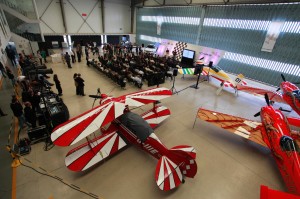
Embraer e Boeing assinam Memorando de Entendimentos para implantar centro de P&D em biocombustíveis sustentáveis no Brasil
May 12, 2014
São José dos Campos – SP, 12 de maio de 2014 – A Embraer e a Boeing assinaram um Memorando de Entendimentos (MoU, na sigla em inglês) para a criação de um Centro Conjunto de Pesquisa na área de Biocombustíveis com o objetivo de desenvolver e amadurecer o conhecimento e as tecnologias que possibilitem o estabelecimento da cadeia de biocombustíveis sustentáveis para a aviação. O Centro deverá ser instalado no Parque Tecnológico – São José dos Campos.
“A Embraer está comprometida em apoiar o desenvolvimento de biocombustíveis sustentáveis para a aviação, e os esforços conjuntos com a Boeing certamente contribuirão para que a empresa siga acompanhando a vanguarda das pesquisas no tema”, diz Mauro Kern, Vice-Presidente Executivo de Engenharia e Tecnologia da Embraer. “O Brasil tem tradição na área de combustíveis alternativos, além de possuir um enorme potencial a ser explorado na pesquisa em bioenergia”, completa.
“A Boeing trabalha com muito empenho em todo mundo para expandir o fornecimento de biocombustível sustentável para aviação e reduzir as emissões de carbono da indústria”, afirma Julie Felgar, diretora executiva de Estratégia e Integração Ambiental da Boeing Aviação Comercial. “Esse centro de pesquisa conjunto mostra o forte compromisso da Boeing e da Embraer para contribuir com o sucesso da indústria de biocombustível sustentável de aviação no Brasil”
“A Boeing e a Embraer têm uma grande oportunidade de trabalhar em parceria para aprimorar as capacidades de biocombustível para aviação do Brasil, e também aumentar o acesso da indústria global ao biocombustível para aviação”, diz Al Bryant, vice-presidente da Boeing Pesquisa & Tecnologia-Brasil.
O projeto deverá agora ser estruturado por meio de um Acordo de Colaboração entre as duas empresas. Está prevista também a possibilidade de que outras empresas e instituições tomem parte nas atividades de Pesquisa & Desenvolvimento.
Histórico – A indústria aeronáutica assumiu o compromisso de reduzir seu impacto ambiental e estabeleceu metas ambiciosas para atingir um crescimento neutro em carbono até 2020 e para reduzir emissões de dióxido de carbono em 50% até 2050, quando comparado aos níveis de emissão de 2005. Hoje, a indústria gera aproximadamente 2% das emissões de dióxido de carbono no planeta.
Diversas iniciativas vêm sendo desenvolvidas, inclusive no Brasil, para que se produza um biocombustível para aviação economicamente viável e que cumpra as estritas exigências aeronáuticas.
Uma dessas iniciativas, foi a demonstração da viabilidade técnica de um biocombustível produzido a partir da cana de açúcar, realizada através de voo-teste com um Embraer 195, durante a Rio+20, em 2012..
Em 2011, uma parceria entre Embraer, Boeing e Fundação de Amparo à Pesquisa do Estado de São Paulo (Fapesp) começou a desenvolver uma investigação que culminou no lançamento do Plano de Voo para Biocombustíveis de Aviação no Brasil: Plano de Ação, ano passado, que aponta os principais rumos para o desenvolvimento de uma indústria sólida e sustentável de biocombustíveis para o setor aéreo no Brasil.


